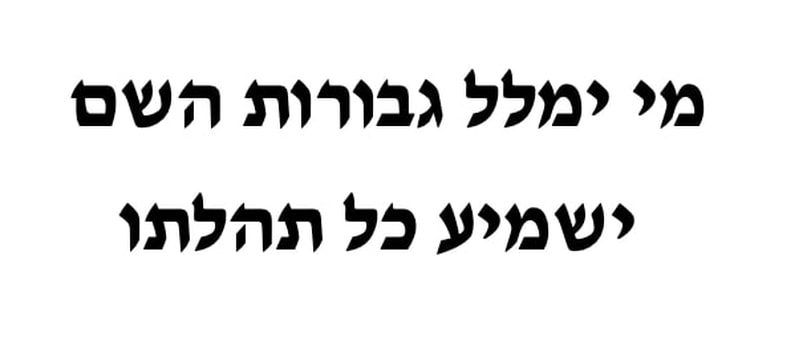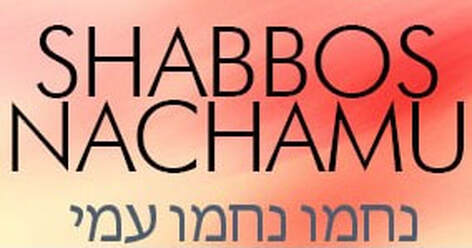 Rabbi David Etengoff Dedicated to the sacred memories of my mother, Miriam Tovah bat Aharon Hakohen, father-in-law, Levi ben Yitzhak, sister, Shulamit bat Menachem, sister-in-law, Ruchama Rivka Sondra bat Yechiel, Chana bat Shmuel, Yehonatan Binyamin ben Mordechai Meir Halevi, Shoshana Elka bat Avraham, Tikvah bat Rivka Perel, Peretz ben Chaim, Chaya Sarah bat Reb Yechezkel Shraga, Shmuel Yosef ben Reuven, Shayndel bat Mordechai Yehudah, the Kedoshim of Har Nof, Pittsburgh, and Jersey City, and the refuah shlaimah of Mordechai HaLevi ben Miriam Tovah, Moshe ben Itta Golda, Yocheved Dafneh bat Dinah Zehavah, Reuven Shmuel ben Leah, and the health and safety of our brothers and sisters in Israel and around the world. Our parasha contains a phrase, familiar to many, that is found in the first blessing (Birkat Avot) of the Shemoneh Esrei: “He is the great (hagadol), mighty (hagibor) and awesome (v’hanorah) G-d (A-le).” (Sefer Devarim 10:17, translation, Rabbi Aryeh Kaplan zatzal, The Living Torah) If it is acceptable to declare, “HaA-le hagadol hagibor v’hanorah,” one might think it is permissible to add other descriptions of the Almighty during the recitation of the Shemoneh Esrei. This approach was undertaken by an anonymous shaliach tzibbur, who, to his surprise, was strongly criticized by Rabbi Chanina bar Chama, as recounted in Talmud Bavli, Berachot 33b: A certain [reader] went down in the presence of Rabbi Chanina and said, “O’ G-d, the great hagadol, hagibor, v’hanorah, majestic, powerful, awe-filled, strong, fearless, sure and honored.” He waited until he had finished, and when he completed [his prayer] he said to him, “Have you concluded all the praise of your Master? Why do we want all this?” (Translation, The Soncino Talmud with my emendations) Rabbi Chanina summarily rejected the shaliach tzibbur’s seven personal additions, asking him the rhetorical question, “Have you concluded all the praise of your Master? Why do we want all this?” Moreover, in the continuation of our Talmudic passage, Rabbi Chanina further teaches us that even our phrase, “HaA-le hagadol hagibor v’hanorah,” would not have been included in the Shemoneh Esrei by the Anshei Kenneset HaGadolah (Men of the Great Assembly), “had not Moshe Rabbeinu mentioned them in the Torah.” The Rambam (Maimonides, 1135-1204) codified this position of the Gemara: A person should not be profuse in his mention of adjectives describing G-d, and say: “The great, mighty, awesome, powerful, courageous, and strong G-d,” for it is impossible for man to express the totality of His praises. Instead, one should mention [only] the praises that were mentioned by Moshe, of blessed memory.” (Mishneh Torah, Hilchot TefilahIX:7, translation, Rabbi Eliyahu Touger) The Rambam’s reasoning as to why one is proscribed from adding new descriptions of Hashem in the Shemoneh Esreiis clear: “for it is impossible for man to express the totality of His praises.” Quite simply, finite man is incapable of properly depicting the majesty and greatness of the Almighty. Therefore, our praises must be limited to the Torah’s own words, no matter how language-adept we may be. Both Rabbi Chanina’s position and the Rambam’s p’sak din (halachic conclusion) were anticipated by Dovid HaMelech in Sefer Tehillim 106:2: “Who can speak of the mighty deeds of the L-rd? [Who] can make heard all His praise?” As Rabbeinu Ibn Ezra (1092-1167) explains in his commentary on Sefer Tehillim: “[Dovid HaMelech] provides us with the rationale as to why we laud Hashem, even though no one has the ability to [accurately] praise His mighty deeds and make known His true degree of greatness, but rather, only a portion thereof.” Closer to our own time, the Malbim’s (1809-1879) gloss on this verse, as found in his commentary on Sefer Tehillim, echoes this interpretation by emphasizing our inability to apprehend Hashem’s essence and the magnitude of His grandeur: “This means we praise Hashem because He is wholly good and His kindness is forever, and not He, Himself [as His essence eludes us], since it is impossible to speak of His mighty deeds m’tzad atzmam (as they are in reality).” (Translations my own) With Hashem’s endless beneficience, may we be zocheh (merit) to grow ever closer to Him. May we realize His goodnesss and recognize that His kindness endures, forevermore. V’chane yihi ratzon. Shabbat Shalom and may Hashem in His infinite mercy remove the pandemic from klal Yisrael and all the nations of the world. Past drashot may be found at my blog-website: http://reparashathashavuah.org The email list, b’chasdei Hashem, has expanded to hundreds of people. I am always happy to add more members to the list. If you have family or friends you would like to have added, please do not hesitate to contact me via email mailto:[email protected]. *** My audio shiurim on the topics of Tefilah and Tanach may be found at: http://tinyurl.com/8hsdpyd *** I have posted 164 of Rabbi Soloveitchik’s English language audio shiurim (MP3 format) spanning the years 1958-1984. Please click on the highlighted link: The Rav zatzal
0 Comments
 Rabbi David Etengoff Dedicated to the sacred memories of my mother, Miriam Tovah bat Aharon Hakohen, father-in-law, Levi ben Yitzhak, sister, Shulamit bat Menachem, sister-in-law, Ruchama Rivka Sondra bat Yechiel, Chana bat Shmuel, Yehonatan Binyamin ben Mordechai Meir Halevi, Shoshana Elka bat Avraham, Tikvah bat Rivka Perel, Peretz ben Chaim, Chaya Sarah bat Reb Yechezkel Shraga, Shmuel Yosef ben Reuven, Shayndel bat Mordechai Yehudah, the Kedoshim of Har Nof, Pittsburgh, and Jersey City, and the refuah shlaimah of Mordechai HaLevi ben Miriam Tovah, Moshe ben Itta Golda, Yocheved Dafneh bat Dinah Zehavah, Reuven Shmuel ben Leah, and the health and safety of our brothers and sisters in Israel and around the world. This week’s haftarah is the single most longed-for haftarah of the entire year. Until now, the Three Weeks and Tisha b’Av have forced us to focus upon the trials and tribulations of our nation’s history. Suddenly, Tisha b’Av ends and we are greeted with Yeshayahu’s proclamation of comfort: “Nachamu nachamu ami yomar Elokeichem” (Sefer Yeshayahu 40:1, “Console console My people says your G-d,” this and all Bible translations, The Judaica Press Complete Tanach) The world returns to its normal rhythms, and we are no longer preoccupied with the dire times of Jewish history. Our national aveilut (mourning) ceases, at last. Yet, what kind of nechama (consolation) has really been achieved? The Beit HaMikdash remains in ruins, anti-Semitism, both in the United States and the rest of the world, grows ever stronger, and Israel is continually reviled in many “halls of justice” throughout the world. Paradoxically, I believe that a powerful response to this question is contained in Megillat Eicha, itself, the megillah of Tisha b’Av that concerns itself with unspeakable tragedy: “This I reply to my heart; therefore, I have hope. Verily, the kindnesses of the L-rd (chasdai Hashem) never cease! Indeed, His mercies (rachamov) never fail! They are new every morning; great is Your faithfulness. ‘The L-rd is my portion,’ says my soul; ‘therefore, I will hope in Him.’” (3:21-24) In the midst of some of the most horrific prophecies ever uttered, Yirmiyahu (Talmud Bavli, Bava Batra 15a) is teaching us a fundamental lesson of faith and hope: “… the kindnesses of the L-rd never cease! Indeed, His mercies never fail! They are new every morning…” No matter what we may encounter in our lives, we must ever remember that “the darkest hour is just before the dawn.” (Thomas Fuller, A Pisgah - Sight of Palestine And The Confines Thereof, 1650) Yirmiyahu is reminding us that we must search ceaselessly for Hashem’s chasadim and rachamim, with the expectation that they will be found. Little wonder, then, that in the very next pasuk in Megillat Eicha he declares: “The L-rd is good to those who wait for Him, to the soul that seeks Him.” Yeshayahu joins Yirmiyahu in urging us to seek out Hashem’s presence. In one of his most famous pasukim he exhorts us: “Dirshu Hashem b’hematzo, k’ra’uhu bi’yoto karov” (“Seek the L-rd where He is found, call Him when He is near,” 55:6) Yet, where, exactly, is Hashem to be found? The Kotzker rebbe zatzal (1787-1859) addresses this question directly in one of his best-known aphorisms: “Where is G‑d? Wherever He is allowed in!” This is a profound idea. It inspires us to allow Hashem into every part of our lives, no matter where we may be, so that we may find Him. As stated by the Kotzker on another occasion: “He who doesn’t see G-d everywhere, isn’t capable of seeing Him anywhere.” (Kotzker quotations, https://www.chabad.org/library/article_cdo/aid/4287676/jewish/48-Wise-and-Deep-Sayings-of-Rabbi-Menachem-Mendel-of-Kotzk.htm) Armed with this enhanced understanding of our haftarah’s pasuk, “The L-rd is good to those who wait for Him, to the soul that seeks Him,” may we go forward with the discernment and heartfelt dedication to ever seek Hashem’s ineffable presence. As Dovid HaMelech said so long ago: “Shiviti Hashem l’negdi tamid” (“I have placed the L-rd before me constantly,” Sefer Tehillim 16:8) V’chane yihi ratzon. Shabbat Shalom and may Hashem in His infinite mercy remove the pandemic from klal Yisrael and all the nations of the world. Past drashot may be found at my blog-website: http://reparashathashavuah.org The email list, b’chasdei Hashem, has expanded to hundreds of people. I am always happy to add more members to the list. If you have family or friends you would like to have added, please do not hesitate to contact me via email mailto:[email protected]. *** My audio shiurim on the topics of Tefilah and Tanach may be found at: http://tinyurl.com/8hsdpyd *** I have posted 164 of Rabbi Soloveitchik’s English language audio shiurim (MP3 format) spanning the years 1958-1984. Please click on the highlighted link: The Rav zatzal Rabbi David Etengoff Dedicated to the sacred memories of my mother, Miriam Tovah bat Aharon Hakohen, father-in-law, Levi ben Yitzhak, sister, Shulamit bat Menachem, sister-in-law, Ruchama Rivka Sondra bat Yechiel, Chana bat Shmuel, Yehonatan Binyamin ben Mordechai Meir Halevi, Shoshana Elka bat Avraham, Tikvah bat Rivka Perel, Peretz ben Chaim, Chaya Sarah bat Reb Yechezkel Shraga, Shmuel Yosef ben Reuven, Shayndel bat Mordechai Yehudah, the Kedoshim of Har Nof, Pittsburgh, and Jersey City, and the refuah shlaimah of Mordechai HaLevi ben Miriam Tovah, Moshe ben Itta Golda, Yocheved Dafneh bat Dinah Zehavah, Reuven Shmuel ben Leah, and the health and safety of our brothers and sisters in Israel and around the world. This week’s haftorah, “Chazon Yeshayahu,” includes the first 29 pasukim of Sefer Yeshayahu. While many of these verses are fascinating and a treasure trove of Jewish thought, I find the final pasuk particularly intriguing: “Zion shall be redeemed through justice (mishpat) and her penitent, bitzdakah.” (This and all Tanach translations, unless otherwise noted, The Judaica Press Complete Tanach) Bitzdakah is a conjunction of the letter bet, with the connotation in our verse of “in” or “through,” and the word tzedakah. In turn, tzedakah may be interpreted as righteousness or charity, and, as we will see, these approaches are followed by various Rabbinic authorities. In the view of Rabbi Yosef Kra ben Shimon zatzal (1065-1135), who is considered one of the leading interpreters of Nach (Navi’im u’Ketuvim), “bitzdakah” in our pasuk must be understood as referring to righteous behavior, as it is in proximity to the word, “mishpat:” And you must know that in every instance that you find the word, “tzedakah,” in proximity to “mishpat,” it does not refer to the giving of money [to the poor,] rather, it is an expression of the rendering of true judgment. So, too, do we find [in reference to Avraham Avinu,] “la’asot tzedakah u’mishpat” (“to perform righteousness and justice,” Sefer Bereishit 18:19), [and regarding Dovid HaMelech:] “va’ye’hi Dovid oseh mishpat u’tzdakah l’chol amo” (“and David performed justice and righteousness for all his people,” Sefer Shmuel II: 8:15, translations and brackets my own) Based upon this analysis, Rav Kra would translate our pasuk as: “Zion shall be redeemed through justice and her penitent in righteousness.” An alternative approach is found in Talmud Bavli, wherein Ula follows the standard meaning of tzedakah and declares: “Yerushalayim will not be redeemed except through tzedakah, as the text states: ‘Zion shall be redeemed through justice and her penitent through tzedakah.’” (Shabbat 139a and Sanhedrin 98a) Since Rashi (1040-1105) does not comment on the meaning of tzedakah in these passages, we may readily assume that he understands it in its normative sense, in consonance with the positions of the Rambam (1135-1204) and the Maharsha (1555-1631: …The throne of Israel will not be established, nor will the true faith stand except through charity, as the text states: “You shall be established through righteousness.” (Sefer Yeshayahu 54:14) And Israel will be redeemed solely through charity, as the text states: “Zion will be redeemed through judgment and those who return to her through charity.” (Rambam, Mishneh Torah, Sefer Zerayim, Matnot Aniyim 10:1, translation, Rabbi Eliyahu Touger) [When the text in Sefer Yeshayahu states: “Zion shall be redeemed through justice and her penitent bitzdakah,” tzedakah actually means] “according to the merit of [the mitzvah of] tzedakah that will exist in that generation.” This is the case, since one who gives of his money, and gives away that which is his to others, will certainly not steal from others. And through this merit, [authentic] judgment will return to Yerushalayim… (Maharsha, Chidushei Aggadot, Sanhedrin 98a, translation and brackets my own) In many ways, the interpretation of tzedakah in our pasuk as charity, and the emphasis of the Rambam and Maharsha upon its singular import, is congruent with a celebrated statement in Talmud Bavli, Bava Batra 9a: “Rav Assi said: ‘Tzedakah is the equivalent of all the mitzvot of the Torah.’” Little wonder, then, that the Rambam ruled at the beginning of the above-cited passage: “We are obligated to be careful with regard to the mitzvah of charity to a greater extent than all [other] positive commandments…” Whether we follow Rabbi Yosef Kra ben Shimon’s lead and interpret tzedakah as righteous actions, or take this term at face value as referring to charity, as do Ula, the Rambam and the Maharsha, the message is clear. Yeshayahu is teaching us that we must be cognizant of our behavior toward others, and act with equity towards all humankind. Through the merit of attaining these often-elusive goals, may we witness our people’s return to Eretz Yisrael and the redemption of Tzion, soon and in our days. V’chane yihi ratzon. Shabbat Shalom and may Hashem in His infinite mercy remove the pandemic from klal Yisrael and all the nations of the world. Past drashot may be found at my blog-website: http://reparashathashavuah.org The email list, b’chasdei Hashem, has expanded to hundreds of people. I am always happy to add more members to the list. If you have family or friends you would like to have added, please do not hesitate to contact me via email mailto:[email protected]. *** My audio shiurim on the topics of Tefilah and Tanach may be found at: http://tinyurl.com/8hsdpyd *** I have posted 164 of Rabbi Soloveitchik’s English language audio shiurim (MP3 format) spanning the years 1958-1984. Please click on the highlighted link: The Rav zatzal  Rabbi David Etengoff Dedicated to the sacred memories of my mother, Miriam Tovah bat Aharon Hakohen, father-in-law, Levi ben Yitzhak, sister, Shulamit bat Menachem, sister-in-law, Ruchama Rivka Sondra bat Yechiel, Chana bat Shmuel, Yehonatan Binyamin ben Mordechai Meir Halevi, Shoshana Elka bat Avraham, Tikvah bat Rivka Perel, Peretz ben Chaim, Chaya Sarah bat Reb Yechezkel Shraga, Shmuel Yosef ben Reuven, Shayndel bat Mordechai Yehudah, the Kedoshim of Har Nof, Pittsburgh, and Jersey City, and the refuah shlaimah of Mordechai HaLevi ben Miriam Tovah, Moshe ben Itta Golda, Yocheved Dafneh bat Dinah Zehavah, Reuven Shmuel ben Leah, and the health and safety of our brothers and sisters in Israel and around the world. The beginning of Parashat Masei presents a puzzling array of places where our forebears traveled on their circuitous journey from Egypt to Eretz Yisrael. Rashi (1040-1105) famously asks the question that in all likelihood has been on the mind of every serious Torah student since time immemorial: “Why were these journeys written [in the Torah text]?” He suggests that the Torah provides us with this long and detailed list “to make known the loving acts of the Omnipresent One” (l’hodiyah chasadov shel Makkom). How is this the case? As Rashi states: …that although He had decreed against them to make them move about and wander in the wilderness, you should not think that they wandered and moved about without cessation from one station to another station all the forty years, and that they had no rest, for you see that there are here only forty-two stages… [Rashi now presents an elaborate case to prove the following statement:] It follows that during the whole of the thirty-eight years they made only twenty journeys. This is excerpted from the work of R. Moses the Preacher. (Translation, Rev. M. Rosenbaum and Dr. A.M. Silberman, Pentateuch with Targum Onkelos, Haphtaroth, and Rashi’s Commentary, Numbers 33:1) Rav Aharon Lichtenstein zatzal (1933-2015) summarizes Rashi’s gloss in these words: “That is to say, the journeys were recorded in order to show the kindness of the Holy One blessed be He, for He did not force them to travel during the entire 40 years, but rather, only 20 times.” (Yeshivat Har Etzion, Sichot Roshei HaYeshivah, Parashat Masei, Erev Shabbat, 1990, summarized by Rabbi Tzvi Reiman, 1994, translation my own) While Rashi focuses upon Hashem’s kindness in limiting our nations’ travels during their time in the Sinai Desert, the Rambam (1135-1204) has a very different perspective as to why the Torah spends 39 verses detailing every journey our ancestors undertook: Of this kind [of narrative that appears superfluous] is the enumeration of the stations [of the Israelites in the wilderness]. At first sight it appears to be entirely useless; but in order to obviate such a notion Scripture says, “And Moses wrote their goings out according to their journeys by the commandment of the L-rd.” (Numbers 33:2). It was indeed most necessary that these should be written. For miracles are only convincing to those who witnessed them; whilst coming generations, who know them only from the account given by others, may consider them as untrue. But miracles cannot continue and last for all generations; it is even inconceivable [that they should be permanent]. Now the greatest of the miracles described in the Law is the stay of the Israelites in the wilderness for forty years, with a daily supply of manna…All these miracles were wonderful, public, and witnessed by the people. But G-d knew that in the future people might doubt the correctness of the account of these miracles. in the same manner as they doubt the accuracy of other narratives; they might think that the Israelites stayed in the wilderness in a place not far from inhabited land, where it was possible for man to live [in the ordinary way] … In order to remove all these doubts and to firmly establish the accuracy of the account of these miracles, Scripture enumerates all the stations, so that coming generations may see them, and learn the greatness of the miracle which enabled human beings to live in those places forty years. (The Guide for the Perplexed, III:50, translation, M. Friedlander, pp. 382-383, underlining my own) According to the Rambam, the Torah provides us with a comprehensive listing of the travels of the Dor HaMidbar (Generation of the Desert) to underscore the authenticity of the multifaceted miracles of their survival in the incredibly hostile environment of the Sinai Desert, “so that coming generations may see them, and learn the greatness of the miracle which enabled human beings to live in those places forty years.” Though, “all these miracles were wonderful, public, and witnessed by the people…G-d knew that in the future people might doubt the correctness of the account of these miracles. in the same manner as they doubt the accuracy of other narratives.” The Torah’s comprehensive account of these travels, therefore, comes to prove their extraordinary nature. Moreover, it illustrates the Almighty’s role as He Who performs ongoing miracles for b’nai Yisrael. In the Modim section of our Shemoneh Esrei, the Anshei Kenesset HaGadolah (Men of the Great Assembly, circa 500 BCE) gave powerful voice to this concept of Hashem as He Who performs ongoing miracles for b’nai Yisrael: We thankfully acknowledge that You are the L-rd our G-d and G-d of our fathers forever. You are the strength of our life, the shield of our salvation in every generation. We will give thanks to You and recount Your praise, evening, morning, and noon, for our lives which are committed into Your hand, for our souls which are entrusted to You, for Your miracles which are with us daily, and for Your continual wonders and beneficences. You are the Beneficent One, for Your mercies never cease; the Merciful One, for Your kindnesses never end; for we always place our hope in You. (Translation, https://www.chabad.org/library/article_cdo/aid/867674/jewish/Translation.htm) With Hashem’s help, and our fervent desire, may we ever acknowledge His immanent role in our existence, and recognize the daily wonders and miracles He performs for us on the journey we call “life.” V’chane yihi ratzon. Shabbat Shalom and may Hashem in His infinite mercy remove the pandemic from klal Yisrael and all the nations of the world. Past drashot may be found at my blog-website: http://reparashathashavuah.org The email list, b’chasdei Hashem, has expanded to hundreds of people. I am always happy to add more members to the list. If you have family or friends you would like to have added, please do not hesitate to contact me via email mailto:[email protected]. *** My audio shiurim on the topics of Tefilah and Tanach may be found at: http://tinyurl.com/8hsdpyd *** I have posted 164 of Rabbi Soloveitchik’s English language audio shiurim (MP3 format) spanning the years 1958-1984. Please click on the highlighted link: The Rav zatzal |
Details
Archives
July 2024
AuthorTalmid of Rabbi Soloveitchik zatzal Categories |
- Blog: Rabbi David Etengoff: Parashat HaShavuah
- Sefer Bereishit 5784&5785
- Sefer Shemot 5784&5785
- Sefer Vayikra 5784&5785
- Sefer Bamidbar 5784 &5785
- Sefer Bereishit 5782&5783
- Sefer Shemot 5782&5783
- Sefer Vayikra 5782&5783
- Sefer Bamidbar 5782&5783
- Sefer Devarim 5782&5783
- Sefer Bereishit 5780& 5781
- Sefer Shemot 5780&5781
- Sefer Vayikra 5780&5781
- Sefer Bamidbar 578&5781
- Sefer Devarim 578&5781
- Sefer Bereishit 5778&5779
- Sefer Shemot 5778&5779
- Sefer Vayikra 5778&5779
- Sefer Bamidbar 5778&5779
- Sefer Devarim 5778&5779
- Sefer Bereishit 5776&5777
- Sefer Bereishit 5774&5775
- Sefer Bereishit 5772&5773
- Sefer Bereishit 5771&5770
- Sefer Shemot 5776&5777
- Sefer Shemot 5774&5775
- Sefer Shemot 5772&5773
- Sefer Shemot 5771&5770
- Sefer Vayikra 5776&5777
- Sefer Vayikra 5774&5775
- Sefer Vayikra 5772&5773
- Sefer Vayikra 5771&5770
- Sefer Bamidbar 5776&5777
- Sefer Bamidbar 5774&5775
- Sefer Bamidbar 5772&5773
- Sefer Bamidbar 5771&5770
- Sefer Devarim 5776&5777
- Sefer Devarim 5774&5775
- Sefer Devarim 5772&5773
- Sefer Devarim 5771&5770

 RSS Feed
RSS Feed
